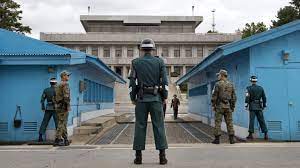Subscribe
Subscribe Now to receive Goldsea updates!
- Subscribe for updates on Goldsea: Asian American Supersite


The South Korean military lacks sufficient artillery-tracing radar systems to be able to effectively counter the threat from across the DMZ, according to a Chosun Daily article.
The deficiency became apparent when the South’s artillery firefinder radar systems couldn’t detect the North Korean artillery shells that fell into waters near the Northern Limit Line close to Yeonpyeong Island on Aug. 10.
The Seoul area, with a population of 25 million, is within range of about 340 long-range artillery pieces that can target 54-65 km (36-41 miles), including 170 mm self-propelled howitzers and 240 mm multiple rocket launchers deployed near the western DMZ. These pieces can fire about 7,000 rounds per hour on Seoul.
The South’s superior air power for preemptive strikes is neutralized by the North’s use of caves to hide its artillery. The big guns can be returned to these caves within five minutes, also taking away the South’s ability to destroy them with a counter-attack. This leaves artillery-tracing radar systems as the only effective means of countering the threat.
South Korea has 20 artillery firefinder radar systems, including the U.S.-made AN/TPQ-36 and 37 firefinders and the Swedish-made Arthur. The range of the TPQ-36 is only 24 km (15 miles) as it is meant to trace mortar fire. The TPQ-37 has a 50 km (31 mile) range. The six Arthur firefinders were bought since 2009 to complement the shorter-range TPQ radars.
But these radar systems have broken down frequently, leaving an insufficient number of functioning units to enable full coverage of artillery directed toward Seoul.
The six new Arthur firefinders deployed at the Third Army headquarters and its five corps broke down 78 times between November 2009 and November 2010, according to data submitted by the Defense Acquisition Program Administration to Future Hope Alliance lawmaker Song Young-sun of the National Assembly’s Defense Committee.
The TPQ-36’s were repaired 98 times and the TPQ-37’s 60 times over the past five years, according to data released by Grand National Party lawmaker Kim Ok-lee of the same committee. Last November’s shelling of Yeonpyeong Island couldn’t be backtraced because a TPQ-37 had broken down.
On Aug. 10, when the North fired artillery shells into waters off Yeonpyeong Island, an Arthur failed to detect the fire because they were in the radar’s blind spot, a situation that could easily be repeated, according to experts.
“The artillery firefinder radar can detect objects at a 60-90 degree angle,” said a military source. “We can cover target areas around the clock only when we operate all radar systems in rotation, so it’s hard to carry out watertight detection of long-range artillery fire only with about 20 radar systems.”
U.S. Forces Korea says it needs about 20 TPQ-37s to watch the frontline areas adequately. The South has fewer than 10. The TPQ-36 costs W3.7 billion ($3.5 mil.) apiece. The TPQ-37 costs W14.7 billion ($13 mil.).
